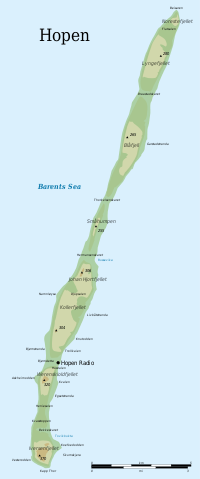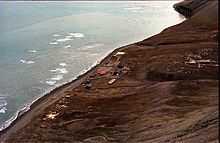Hopen, Svalbard
 Hopen in the southeast. | |
| Geography | |
|---|---|
| Location | Arctic Ocean |
| Coordinates | 76°33′N 25°7′E / 76.550°N 25.117°ECoordinates: 76°33′N 25°7′E / 76.550°N 25.117°E |
| Archipelago | Svalbard |
| Area | 47 km2 (18 sq mi) |
| Length | 33 km (20.5 mi) |
| Width | 2 km (1.2 mi) |
| Highest elevation | 370 m (1,210 ft) |
| Highest point | Iversenfjellet |
| Country | |
|
Norway | |
| Demographics | |
| Population | 4 |
Hopen is an island in the southeastern part of the Svalbard archipelago (Norway). Hopen was discovered in 1613, probably by Thomas Marmaduke of Hull, who named it after his former command, the Hopewell.
The Norwegian Meteorological Institute (Norges Meteorologiske Institutt) operates a manned weather station on the island with a staff of four persons. For the welfare of the crew, there are three cabins available on the island for their use.
During World War II, the Luftwaffe placed a meteorological team there under cover of Operation Sizilien.
Environment
A significant number of Polar bears are found at Hopen in the winter;[1] moreover, the sub-population of Ursus maritimus found here is a genetically distinct taxon of Polar Bears associated with the Barents Sea region.[2]
Important Bird Area
The island has been identified as an Important Bird Area (IBA) by BirdLife International. It supports breeding populations of Black-legged Kittiwakes (40,000 pairs), Thick-billed Guillemots (150,000 individuals) and Black Guillemots (1000 pairs).[3]
Gallery
-

Hopen meteorological station, seen from north
-

The southernmost point, Kapp Thor, and the highest point, Iversenfjellet (370 m) seen from south
References
- ↑ Oysten Wiig and Kjell Isaksen
- ↑ C. Michael Hogan, 2008
- ↑ "Hopen Island". Important Bird Areas factsheet. BirdLife International. 2013. Retrieved 2013-08-22.
- C. Michael Hogan (2008) Polar Bear: Ursus maritimus, Globaltwitcher.com, ed. Nicklas Stromberg
- Oysten Wiig and Kjell Isaksen Seasonal Distribution of Harbour Seals, Bearded Seals, White Whales and Polar Bears in the Barents Sea
External links
| ||||||||||||||||||||||||||||||||||||||
| |||||